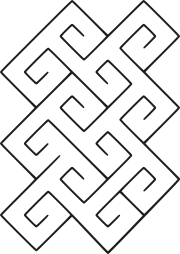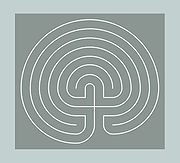
Celtic maze
Encyclopedia
A Celtic maze is a straight-line
spiral
pattern
drawn all over the world beginning in prehistory
. The patterns originate in early Celtic developments in stone and metal-work, and later in medieval Insular art
. Prehistoric spiral designs date back to Gavrinis
(circa 3,500 BCE).
 The straight-line spirals of Celtic labyrinths originated in chevrons and lozenges and are drawn by the Celts using a connect the dots
The straight-line spirals of Celtic labyrinths originated in chevrons and lozenges and are drawn by the Celts using a connect the dots
method.
 Celtic labyrinths are found among carvings at Camonica Valley, occupied by the Celts early in the first millennium, most older than the one Knossos
Celtic labyrinths are found among carvings at Camonica Valley, occupied by the Celts early in the first millennium, most older than the one Knossos
or Classical style example found there. The mythology associated with the labyrinths also suggest Celtic origin. For example, the labyrinths containing eyes or a figure with horns and a snake about its waist imply the deity Cernunnos
. Lastly, Celtic examples resembling the Cretan model but featuring path-line reversal (the path of one is traceable as the line of the other) suggest Celtic pre-knowledge of their construction. Methods of constructing Classical labyrinths from figure with serpent through waist and ocular spiral may be demonstrated.
Line (mathematics)
The notion of line or straight line was introduced by the ancient mathematicians to represent straight objects with negligible width and depth. Lines are an idealization of such objects...
spiral
Spiral
In mathematics, a spiral is a curve which emanates from a central point, getting progressively farther away as it revolves around the point.-Spiral or helix:...
pattern
Pattern
A pattern, from the French patron, is a type of theme of recurring events or objects, sometimes referred to as elements of a set of objects.These elements repeat in a predictable manner...
drawn all over the world beginning in prehistory
Prehistory
Prehistory is the span of time before recorded history. Prehistory can refer to the period of human existence before the availability of those written records with which recorded history begins. More broadly, it refers to all the time preceding human existence and the invention of writing...
. The patterns originate in early Celtic developments in stone and metal-work, and later in medieval Insular art
Insular art
Insular art, also known as Hiberno-Saxon art, is the style of art produced in the post-Roman history of Ireland and Great Britain. The term derives from insula, the Latin term for "island"; in this period Britain and Ireland shared a largely common style different from that of the rest of Europe...
. Prehistoric spiral designs date back to Gavrinis
Gavrinis
Gavrinis is a small island, situated in the Gulf of Morbihan in Brittany, France. It contains the Gavrinis tomb, a megalithic monument notable for its abundance of megalithic art in the European Neolithic. Administratively, it is part of the commune of Larmor-Baden.-Geography:Reachable by boat...
(circa 3,500 BCE).

Connect the dots
Connect the dots, also known as dot to dot or join the dots is a form of puzzle containing a sequence of numbered dots. When a line is drawn connecting the dots the outline of an object is revealed. The puzzles often contain simple line art to enhance the image created or to assist in rendering a...
method.

Knossos
Knossos , also known as Labyrinth, or Knossos Palace, is the largest Bronze Age archaeological site on Crete and probably the ceremonial and political centre of the Minoan civilization and culture. The palace appears as a maze of workrooms, living spaces, and store rooms close to a central square...
or Classical style example found there. The mythology associated with the labyrinths also suggest Celtic origin. For example, the labyrinths containing eyes or a figure with horns and a snake about its waist imply the deity Cernunnos
Cernunnos
Cernunnos is the conventional name given in Celtic studies to depictions of the horned god of Celtic polytheism. The name itself is only attested once, on the 1st-century Pillar of the Boatmen, but depictions of a horned or antlered figure, often seated in a "lotus position" and often associated...
. Lastly, Celtic examples resembling the Cretan model but featuring path-line reversal (the path of one is traceable as the line of the other) suggest Celtic pre-knowledge of their construction. Methods of constructing Classical labyrinths from figure with serpent through waist and ocular spiral may be demonstrated.
See also
- Celtic knotCeltic knotCeltic knots are a variety of knots and stylized graphical representations of knots used for decoration, used extensively in the Celtic style of Insular art. These knots are most known for their adaptation for use in the ornamentation of Christian monuments and manuscripts, such as the 8th-century...
- LabyrinthLabyrinthIn Greek mythology, the Labyrinth was an elaborate structure designed and built by the legendary artificer Daedalus for King Minos of Crete at Knossos...
- Prayer Labyrinth
- MazeMazeA maze is a tour puzzle in the form of a complex branching passage through which the solver must find a route. In everyday speech, both maze and labyrinth denote a complex and confusing series of pathways, but technically the maze is distinguished from the labyrinth, as the labyrinth has a single...
, whose technical definition does not include "Celtic mazes" - SpirangleSpirangleSpirangles are geometric figures related to spirals. They are similar to spirals in that they expand from a center point as they grow larger, but they are made out of straight line segments, instead of curves...

